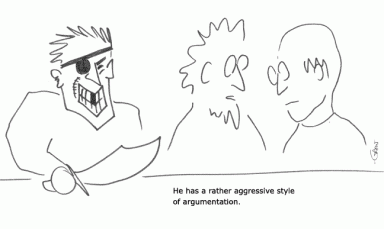Social phobia (aka ‘social anxiety’) has been described by psychoanalysts as fear which stems from internal anxiety. It’s commonly exhibited during interactions in which the person inflicted is performing an act during which they may be scrutinized by others. Examples of this include public speaking, writing, and social interactions (e.g., parties, classes, jobs). Symptoms almost always include sweating, blushing and shaking. Psychoanalysts suggest that social phobia is the displacement of some implicit feeling of shortcoming that is the result of specific experiences. Participants suffering from social phobia report feelings of inadequacy, fear of rejection, submit to more strict social behavior standards, and fear that others will notice their anxieties. (Liebowitz, Gorman, Fyer, & Klein, 1984)
Though social interactions have been facilitated with increasing frequency online, dealing with social phobia must still be a priority for those suffering from it. Phobias can become debilitating and begin affecting the patient’s ability to perform everyday functions. Chayko (2008) notes that online interactions facilitate increased levels of trust and intimacy between people and within social groups due to the anonymity inherent in them. Gackenbach (2009) describes the disinhibition effects that occur as a function of virtual interactions. Essentially, when individuals feel a level of safety, they allow themselves more freedom of expression. Boundaries which are typically very rigid may become broader and less strictly adhered to by those communicating virtually.
Studies have found this to be true of users of social media such as Facebook (Orr et al, 2009). Social media not only allows individuals to develop relationships with those whom they know minimally in real life, but they allow for the continued participation in existing offline relationships. Additionally, studies have shown that individuals who tend to be more socially inept, find social interactions in massively multiplayer online role-playing games (MMORPGs) more attainable and less fear inducing (Cole & Griffiths, 2007). MMORPGs allow players to commit to common goals, form groups which work together to procure resources, plan participant roles, identities, and allow all interactions to be kept at a safe, anonymous distance if need be.
However, no one media is sufficient to resolve social phobia. As with anything, convergence means taking advantage of every media’s strength and using the collective group of media simultaneously to reach a specific goal. In this case, while social media allows for disinhibition and more frequent socialization, as well as control over one’s immediate surroundings during use, it doesn’t allow the individual to learn to cope with offline interactions. Games, while they allow for teamwork and identity expression, don’t necessarily allow for the development of these skills in offline situations either. Media which allow for the optimization of benefits from both social media and gaming, with additional support for transferring those skills from online to offline situations, present a possible solution.
One such media is augmented reality (AR). By definition, AR is the layering of virtual content over actual, present, reality. It is meant to enhance existing ‘content’ by allowing access to more information than is innately available. Imagine an AR application which someone who was socially phobic could take into a work party; perhaps in the form of a contact lens. Say this application monitored groups (e.g., how many people were clumped together), conversations (e.g., what they were talking about), gathered information about social norms for the group and suggested courses of action for the individual (e.g., suggested conversation topics, which groups may be more amenable to additional participants, which foods may be least messy to eat, etc.). This application could be programed to work in a number of social situations such as public speaking, shopping, dining out, and travelling. Additional functions could include situations under which users could practice the application and set preferences according to their personal fears and responses. The application could also be made to monitor autonomic arousal responses (much like a heart rate monitor on a treadmill) and alter suggestions based on the somatic responses of the user.
Augmented reality applications, though not perfect by any means, presents an alternative to specifically online or offline situations by creating a combination of the two. Though psychoanalysts may take issue with AR as therapy for social phobia, if an individual is given more control over their surroundings in the form of AR, there is every possibility that it can act as a sort of placebo which eases somatic responses to the phobias. The more open minded we as consumers are to augmented reality the more avenues open for therapy alternatives and psychological research in general.
References
Chayko, M. (2008). Portable communities : the social dynamics of online and mobile connectedness. Albany: SUNY.
Cole, H., & Griffiths, M. (2007). Social interactions in massively multiplayer online role-playing gamers. CyberPsychology & Behavior, 10(4), 575-583. doi: 10.1089/cpb.200739988
Gackenbach, J. (Ed.). (2007). Psychology and the internet : intrapersonal, interpersonal, and transpersonal implications. Amsterdam; Boston: Elsevier/Academic Press.
Liebowitz, M., Gorman, J., Fyer, A., & Klein, D. (1985). Social phobia: Review of a neglected anxiety disorder. Arch Psychology, 45, 729-736. Retrieved from: http://archpsyc.jamanetwork.com/
Orr, E. S., Sisic, M., Ross, C., Simmering, M. G., Arseneault, J. M., & Orr, R. R. (2009). The influence of shyness on the use of Facebook in an undergraduate sample. CyberPsychology & Behavior, 12(3), 337–340. doi:10.1089/cpb.2008.0214
 If we objectively define ‘scholarly’ as “concerned with academic learning and research” (Dictionary.com, 2012), we find ourselves with a vague definition. We may be tempted to immediately think of left-brained academics. However, discrepancies in what must be considered academic may change that definition. If, for example, we define academics as pertaining to sciences or literacy, we end with a very different result than if we define academics as pertaining to any subject which facilitates the further development of a particular skill. Sir Ken Robinson (2006) notes that a major short coming of academics now is that we define academics much like the former, but would be served better to treat it as the latter.
If we objectively define ‘scholarly’ as “concerned with academic learning and research” (Dictionary.com, 2012), we find ourselves with a vague definition. We may be tempted to immediately think of left-brained academics. However, discrepancies in what must be considered academic may change that definition. If, for example, we define academics as pertaining to sciences or literacy, we end with a very different result than if we define academics as pertaining to any subject which facilitates the further development of a particular skill. Sir Ken Robinson (2006) notes that a major short coming of academics now is that we define academics much like the former, but would be served better to treat it as the latter. However, in writing, the target audience is the one that matters. As such, if you are writing to a group of social scientists, the expectation is that the prescribed protocol will be followed (Polkinghorne, 2007), and so on. In this way then, scholarly writing should be defined more along the lines of writing which facilitates the communication of critical thinking and rhetoric within a given field, using the prescribed masteries of that field. This allows for all subjects regardless of the paradigm currently subscribed to in academia.
However, in writing, the target audience is the one that matters. As such, if you are writing to a group of social scientists, the expectation is that the prescribed protocol will be followed (Polkinghorne, 2007), and so on. In this way then, scholarly writing should be defined more along the lines of writing which facilitates the communication of critical thinking and rhetoric within a given field, using the prescribed masteries of that field. This allows for all subjects regardless of the paradigm currently subscribed to in academia.












